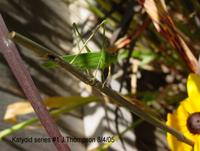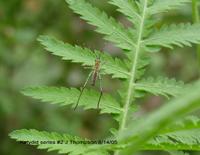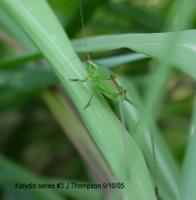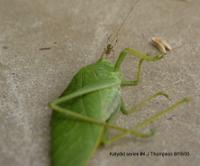
This is a very young katydid nymph balancing on a pennisetum setaceum flower. I would say the species is the forktailed bush katydid, scudderia furcata. Someone named Scudder described the species in this genus, and so all these very adorable stiped-legged and banded antennaed katydids are named after him.
Katydids are closely related to grasshoppers; both have very cute young, and though I have never known them to be much of a problem in the garden or landscape, katydids like grasshoppers can be agricultural pests. An important component of a control program for pest species is a clear understanding of the life cycle and population dynamics through the year. The UC Davis IPM site states these katydids produce one generation per year, with the nymphs appearing in April/May and maturing in 2 to 3 months. How do my observations connect with this information?
The following photo sequence follows a hypothetical Forktailed Bush Katydid's life in the following steps:
1. An adult photographed on August 4.
2. Here is a fairly young, extremely cute nymph on August 14. Is this individual on of the first one's offspring? If so, in my locale the nymphs emerge quite a bit later (3.5 months later). Or is this a member of the second generation? It's possible if her parent hatched in April or even May. Hmmm.
3. Here is a more mature nymph observed on September 16.
4. And here is an adult dying possibly of old age or disease on Sept 18, just about two months after the fairly young and terribly cute nymph pictured on 8/14. (btw, The small spider here was actually tending the katydid, which was still living, as prey)

The photo at the top of this post of the very young katydid, probably just a few days after hatching, was taken September 23; I'm thinking this must represent another generation. Either we have at least two, but maybe three generations of FBKs, or there's some mechanism that staggers development stages of the "one" generation over at least 6 months--ie what is the life span of an adult individual?; or the UC Davis info is based on a much colder climate.



One thing is known for sure, these little katydids are very very very cute, and so it would be good to know when they emerge just so you could have a look.
14 comments:
you are right they are extremely cute. I think your blog is great and hope you don't mind if, on the odd occasion, I borrow youe style and post a couple of insects on my blog. A while back I spent a lot of time taking pictures of insects. But I don,t know the scientific whoodya watsits that go with it.
I saw a green spider in the house I lived in, in Ojai. Never saw one like it, I have a picture of it.
We even called over a friend who is an entomologist, and she had never seen one either.
Do you know what kind of species it was? Or was it just green because of inexperience, ha ha ha.
I'd like to know! I have a picture of it,if you'd like to see it, I can put it on my blog.
I think there are a few possible explanations: Is it possible the female katydid may retain the sperm inside her and lay multiple clutches of eggs, which hatch at different times?
Depending on where the insects live and how much food is available, some individuals may be growing and maturing more quickly than others.
Late-maturing individuals' eggs may overwinter if it's too cold. The ones that matured early laid eggs that have already hatched.
Just my thoughts
you are a star~i can't quite believe a person can ever require this many knowledge
I like taking bug pics too. Check out my blog. There are lots of bug pics (and pics of other stuff too). I don't always know what kind of bug I've gotten a picture of but I try to ID them.
love you blog..
hit my interest right on spot..
Hahaa.
keep it up!!
who does those photography for u ....if u are the man with the camera its simply marvellous...i know u already know that...insects are ok but i love the bigger animals those that cld be spotted without strain...
Ash.
Ps the pictures are amazing....
Wow the pics are great! I got a great time looking at them. I'm into bio too hahaha~
Very nice blog, great pics
What an interesting blog you have. Thanks for posting.
Locusts Plagues: Why not harvest them?
Small airships trailing nets could trawl locusts out of the air. Would make good stock feed, or human feed?
I get told "too expensive" but how could it cost more than aircraft spraying expensive toxins?
When the airship has a sackfull drop it with a gps reading and a truck can pick it up.
Sharmila: I would like to see your spider photo, of course.
Giordano: Interesting idea. I'm pretty sure people in some cultures do eat grasshoppers.
Cindy: I think your explanation #s 2 is not likely since all of these individuals developed in the same environment w/same food source. If #3 is true, what do you think becomes of the current batch of hatchlings? Overwinter, since in two months it will be November. But I'm suspecting the young nymph pictured in August was the offspring of the early-matured individuals, given they supposedly emerged in April/May. But your explanation #1, now THAT could be it. Question: If these katydids are laying multiple clutches, is there an environmental trigger for this behavior, or is this just the way of the katydid?
Phew, why can't someone fund a project to put itty bitty transponders on these buggies so we'll know once and for all what they're up to? I'm going to keep my eye on them, anyway, and verify how late very young nymphs are present in my area. Also, how early next spring.
Nice blog, nice bugs. I like the picture. I came from Indonesia. Come here :D N u will find lot of interesting bugs here :D
Vanessa, great blog. With regard to their being several hatchings of Scudderia in a year, check out "NOTES ON THE BIOLOGY OF KATYDIDS IN SAN JOAQUIN VALLEY STONE FRUIT ORCHARDS" in the UC Plant Protection Quarterly (http://www.uckac.edu/ppq/PDF/01Oct.pdf).
They also find nymphs late in the season. Other life history detail there, too.
Post a Comment